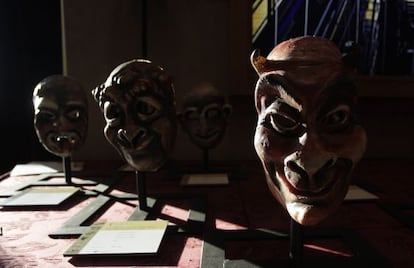Going for a song? Teatro Real auctions off pieces of operas past
Over 1,000 costumes, masks, wigs, furniture and props to go under the hammer


The ghosts of operas past have returned to haunt the elegant labyrinth that is the entrance hall, staircase and hallways of the Teatro Real in Madrid. There, close enough for anyone to touch, are the characters from the theater's 2003 production of Isaac Albéniz's Merlin, or those from the 1999 staging of Bizet's Carmen, or the 2005 version of Mozart's Don Giovanni, among many others.
In total there are over 1,000 items, ranging from costumes, masks and wigs to furniture and stage props, made in the theater workshops and used in productions from 1997 onwards. And the best part is that anyone can take them home — for a price.
All the items will be auctioned off on December 26 as part of an initiative called La Almoneda del Real (Auction at the Real). Similar sales have been held at other major European opera houses, such as Covent Garden in London and the Opéra Nationale de Paris.
The items vary wildly in nature and price: there are objects with a starting price of 20 euros, while the most expensive piece is a scale model of a 1930 Packard LeBaron car that was built for Don Giovanni and will admit no lower bid than 7,800 euros. A model of a horse used in the same opera is going for 1,500 euros; the Excalibur sword from Merlin has a starting price of 150 euros; Morgana's dress starts at 1,500 euros; a mining wagon used in Macbeth begins at 180 euros; and a makeup kit used in Japanese Kabuki theater has an initial price tag of 40 euros.
Items include a scale model of a 1930s Packard LeBaron car
Organizers figure that if all the stock gets sold at opening prices, they will make around 80,000 euros, but the final sum from the bids could double or even triple that amount. The Teatro Real's 2013 budget was 42,495,291 euros, down 30.6 percent from the previous year because of cuts to public subsidies.
The idea, says the director, is to invest all proceeds from the auction into the theater's educational project, "or perhaps extend the youth discount from the current upper age limit of 30 to 35." Right now, people under 30 can buy tickets at just 10 percent of the regular price.
"The initiative began as a way of finding an outlet for some of the pieces stored in the 40 giant shipping containers we have in Arganda," explains Ignacio García-Belenguer, director general of the theater. "It is also a way to acknowledge the valuable work of our artists and craftspeople, who are highly skilled workers."
The opera house has its own workshops, which produce costumes, props, machines, stage mechanics and many other elements needed for opera productions. The technical team is 250 strong. "This is also a way to reach a certain audience that we would otherwise never reach," says the director. "It allows people to get to know the theater and discover what's behind an opera house, which can be a little intimidating sometimes."
Besides the 14 floors above ground, the theater has eight underground levels
Behind the Teatro Real lies a fascinating microcosm. The building is something like a semi-buried skyscraper: besides the 14 floors above ground, there are eight underground levels of which few people are aware. The stage box is an enormous hole in which three separate stages rotate depending on which one is needed, with the aid of a complex mechanism. "Having this type of stage lets you play around with several types of performances," explains García-Belenguer. "A concert today, an opera tomorrow, a children's show in the morning... We move the stages around and thus have more to offer. We can have performances nearly every day of the year."
The rehearsal rooms and the various workshops are located in the part of the theater that the public never gets to see. Inside the wardrobe workshop, employees are busy either creating new costumes or working to keep those being used on stage in tiptop shape. There is much washing, ironing, cutting and sewing going on, and the mood is busy, reminiscent of a ship's crew.
"Our tailoring workshop is not like that of an average theater," explains Ovidio Ceñera, the head of the department. "We maintain the wardrobe and see to the singer or actor's needs, but we also do entire productions, around half of all those programmed." Some of the most recent have been Mussorgsky's Boris Godunov, Philip Glass's The Perfect American and Mozart's Così fan tutte.
"The starting prices for the auction are laughable," adds Ceñera. "There are items that could be used as costumes, but others could be worn on the street. And some are for mythomaniacs, like the headdress we made for [Spanish soprano] María Bayo or the outfit we created for [mezzo-soprano] María José Montiel for the 150th anniversary of the theater. They were only used once."
As a curiosity, even the old ushers' uniforms are being auctioned off after the theater's previous artistic director, Gérard Mortier, had them changed when he took up his position. These are going for 30 euros each.
Tu suscripción se está usando en otro dispositivo
¿Quieres añadir otro usuario a tu suscripción?
Si continúas leyendo en este dispositivo, no se podrá leer en el otro.
FlechaTu suscripción se está usando en otro dispositivo y solo puedes acceder a EL PAÍS desde un dispositivo a la vez.
Si quieres compartir tu cuenta, cambia tu suscripción a la modalidad Premium, así podrás añadir otro usuario. Cada uno accederá con su propia cuenta de email, lo que os permitirá personalizar vuestra experiencia en EL PAÍS.
¿Tienes una suscripción de empresa? Accede aquí para contratar más cuentas.
En el caso de no saber quién está usando tu cuenta, te recomendamos cambiar tu contraseña aquí.
Si decides continuar compartiendo tu cuenta, este mensaje se mostrará en tu dispositivo y en el de la otra persona que está usando tu cuenta de forma indefinida, afectando a tu experiencia de lectura. Puedes consultar aquí los términos y condiciones de la suscripción digital.
Últimas noticias
The complicated life of Francesca Albanese: A rising figure in Italy but barred from every bank by Trump’s sanctions
How Japan is trying to avert ‘digital defeat’
Half of Scotland is in the hands of 420 property owners
Reinhard Genzel, Nobel laureate in physics: ‘One-minute videos will never give you the truth’
Most viewed
- Pablo Escobar’s hippos: A serious environmental problem, 40 years on
- Reinhard Genzel, Nobel laureate in physics: ‘One-minute videos will never give you the truth’
- Why we lost the habit of sleeping in two segments and how that changed our sense of time
- Charles Dubouloz, mountaineering star, retires at 36 with a farewell tour inspired by Walter Bonatti
- The Florida Keys tourist paradise is besieged by immigration agents: ‘We’ve never seen anything like this’








































